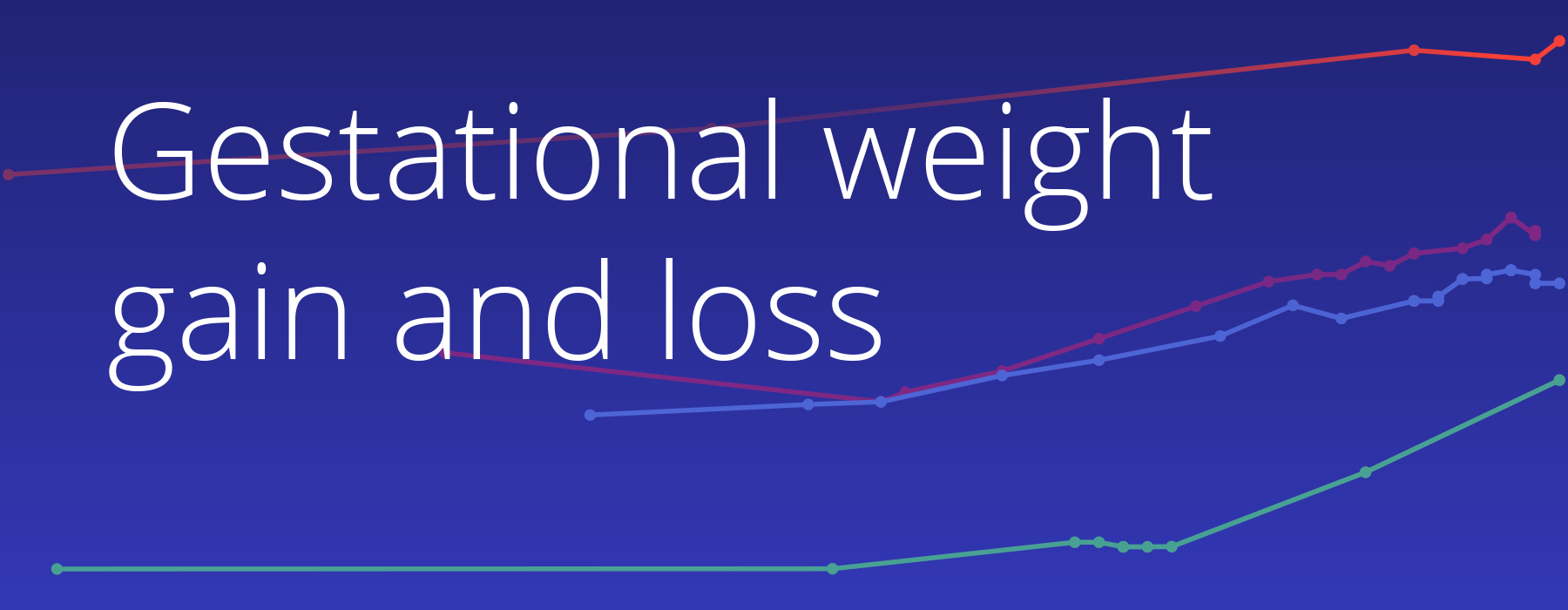- Across their pregnancies, mothers had an average of 12 weight measurements, allowing us to construct a longitudinal ‘journey’ of their weight change.
- Mothers gained an average of 31 pounds across their pregnancies and 45% of mothers had evidence of some weight loss. Among those who lost weight, the average weight loss was 6.9 pounds.
- Weight gain varied with BMI category, where mothers gained less weight with increasing BMI category, consistent with the American College of Obstetricians and Gynecologists (ACOG) guidelines.
Weight gain during pregnancy can be a sensitive subject and is also highly variable from pregnancy to pregnancy. Guidelines on how much weight a mother should gain across her pregnancy vary between countries (1, 2). Many studies provide strong evidence that greater maternal weight gain during pregnancy is associated with higher infant birth weight (3); however, the timing of weight gain across different trimesters may play an important role.
The American College of Obstetricians and Gynecologists (ACOG) has recommended weight gain classified by pre-pregnancy weight category. Mothers who are underweight before pregnancy (BMI <18.5) should gain 28–40 pounds, those of normal weight (BMI 19.0-24.9) should gain 15-25 pounds, those with overweight (BMI 25.0-29.9) should gain 15-25 pounds, and those with obesity (BMI ≥30.0) should gain 11–20 pounds (4).
We were curious to further understand the trajectories of gestational weight gain and/or loss throughout the course of a pregnancy. You can explore this full study, including methodology, definitions, and the full analysis, directly in Truveta Studio.
Methods
Within a subset of Truveta Data, we created a cohort of mothers with a live birth event at a Truveta member health care system and evidence of a linked child. We captured the first live birth event for pregnant mothers aged 18-50 years who had a linked child and delivery date between January 2019 – August 2025. Mothers with diagnostic codes associated with preterm births were removed from the analysis, as were births of multiples (i.e., twins) due to differences in maternal weight gain and newborn weights associated with multiples.
Plausibility rules were applied to maternal weights within each unit (pounds, kilograms, ounces, and grams). Mothers were required to have a valid starting weight (80 to 600 lbs) and BMI measurement between 37 and 65 weeks prior to delivery to be used as the pre-pregnancy weight and BMI. Mothers were also required to have a weight measurement taken 23 to 29 weeks prior to delivery, roughly corresponding to the end of the first trimester for those with term pregnancies, and a weight taken within one week prior to delivery (to be used as the final weight).
The first pregnancy weight and BMI were captured as the weight and BMI measurements recorded closest to 40 weeks prior to delivery and no more than 37 weeks prior to delivery. Total weight gain during pregnancy was defined as the difference between the starting and final weights. Weight loss during pregnancy was defined as the difference between the starting weight and minimum recorded weight during pregnancy. Mothers were classified into pre-pregnancy weight categories by their pre-pregnancy BMI measurement (underweight, normal, overweight, and obesity).
For each mother, we constructed a weight trajectory throughout pregnancy. The figure below highlights four women and their individual weight trajectories, with one sampled mother from each BMI category. You can see that Mother 3, in purple, had some weight loss between her starting weight and her weight at 28 weeks prior to delivery, indicative of first trimester weight loss. However, she then started gaining weight and ultimately gained 25 pounds. By contrast, the other three sampled mothers didn’t lose weight over their pregnancies.
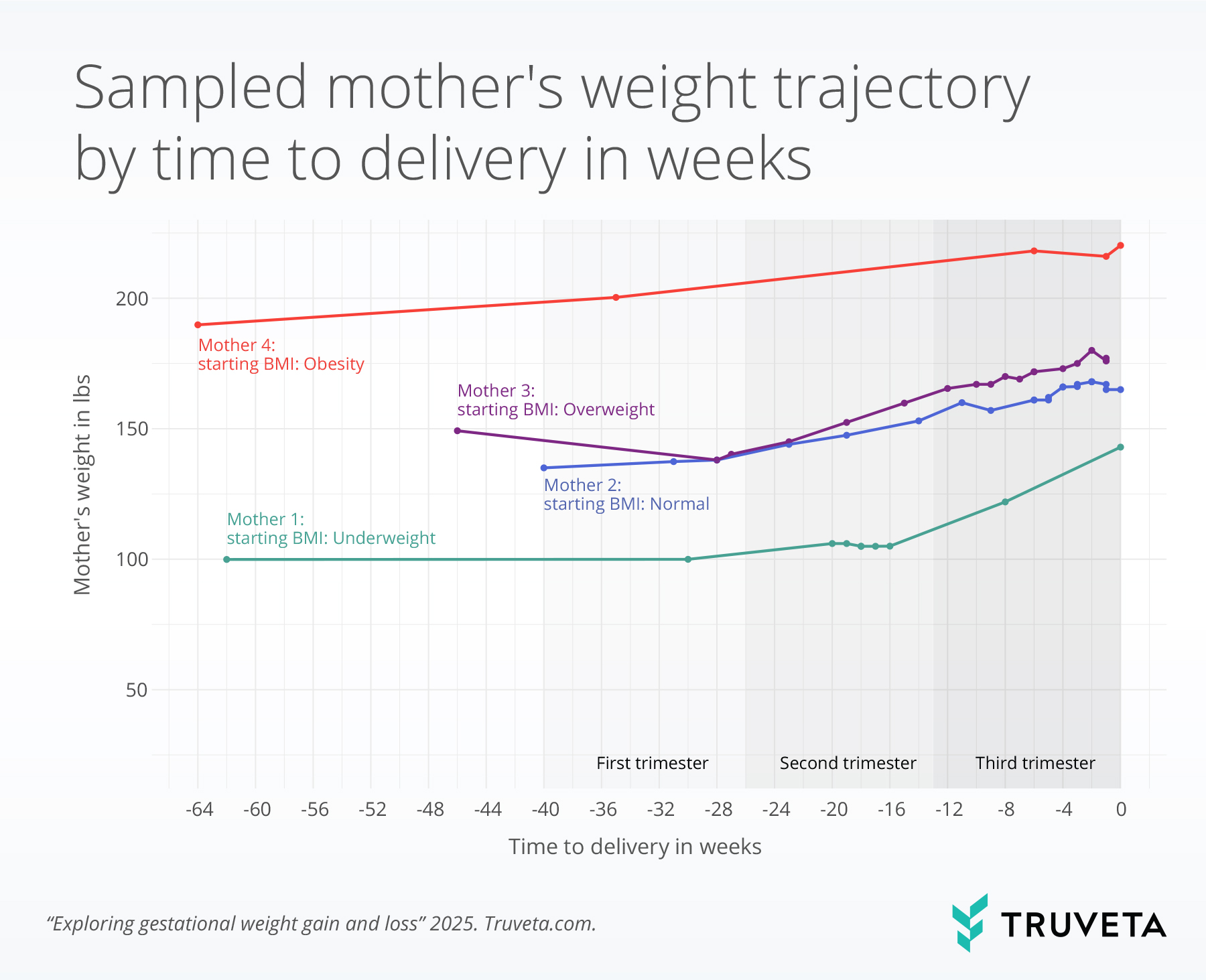
We explored maternal weight gain and loss patterns by sociodemographic factors including race, age, ethnicity, and starting BMI category. We present data as boxplots, described below.
Results
Population
We included 117,752 pregnant mothers who gave birth between January 2019 and August 2025. Overall, most mothers were White and non-Hispanic, and most were 30-39 years old at delivery. Few mothers were underweight by BMI category, and most had normal BMI or had obesity prior to pregnancy.
Mothers had an average of 12 weight measurements over their pregnancy, and the average weight gain was 31 pounds, while the average weight loss was 6.9 pounds among mothers who lost weight.
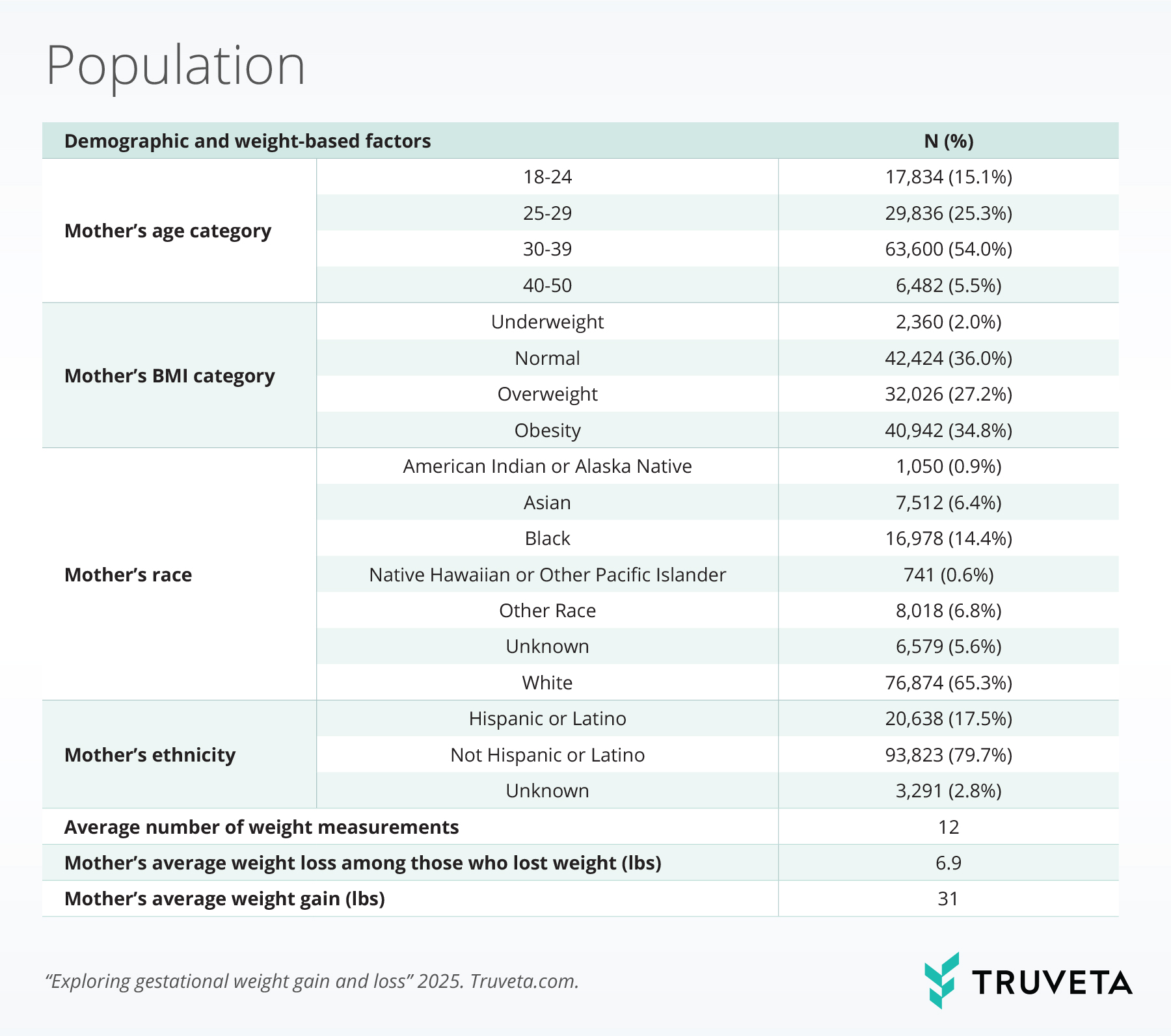
Gestational weight gain patterns
Overall, we saw that weight gain across mothers in this study broadly mirrored the ACOG recommendations, with women gaining more weight if their BMI indicated underweight or normal weight than those with overweight or obesity prior to pregnancy.
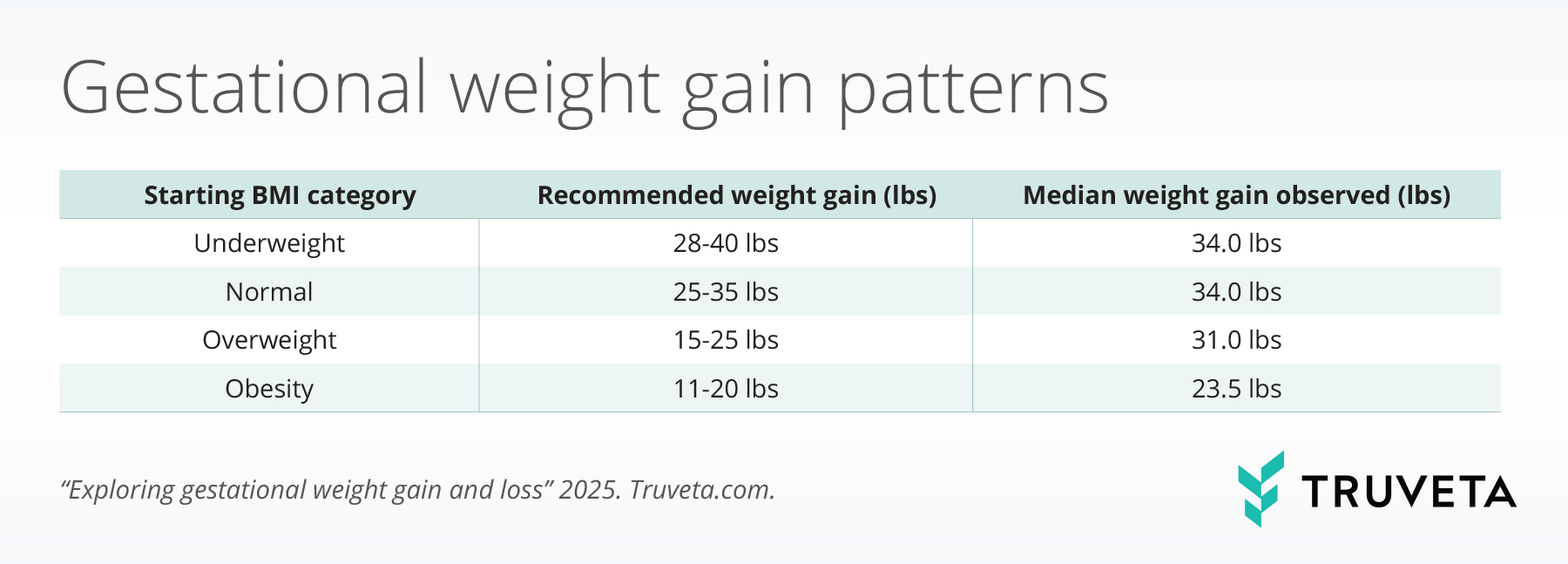
The below boxplot shows gestational weight gain across BMI category. The line inside each box represents the median weight gain (or the 50th percentile). The bottom and top of the box mark the 25th and 75th percentile. Together the vertical space inside the box represents the middle half of all women. This is known as the interquartile range. The whiskers, or thin lines extending from the box, show typical lower and higher values, reaching up to 1.5 times the height of the box.
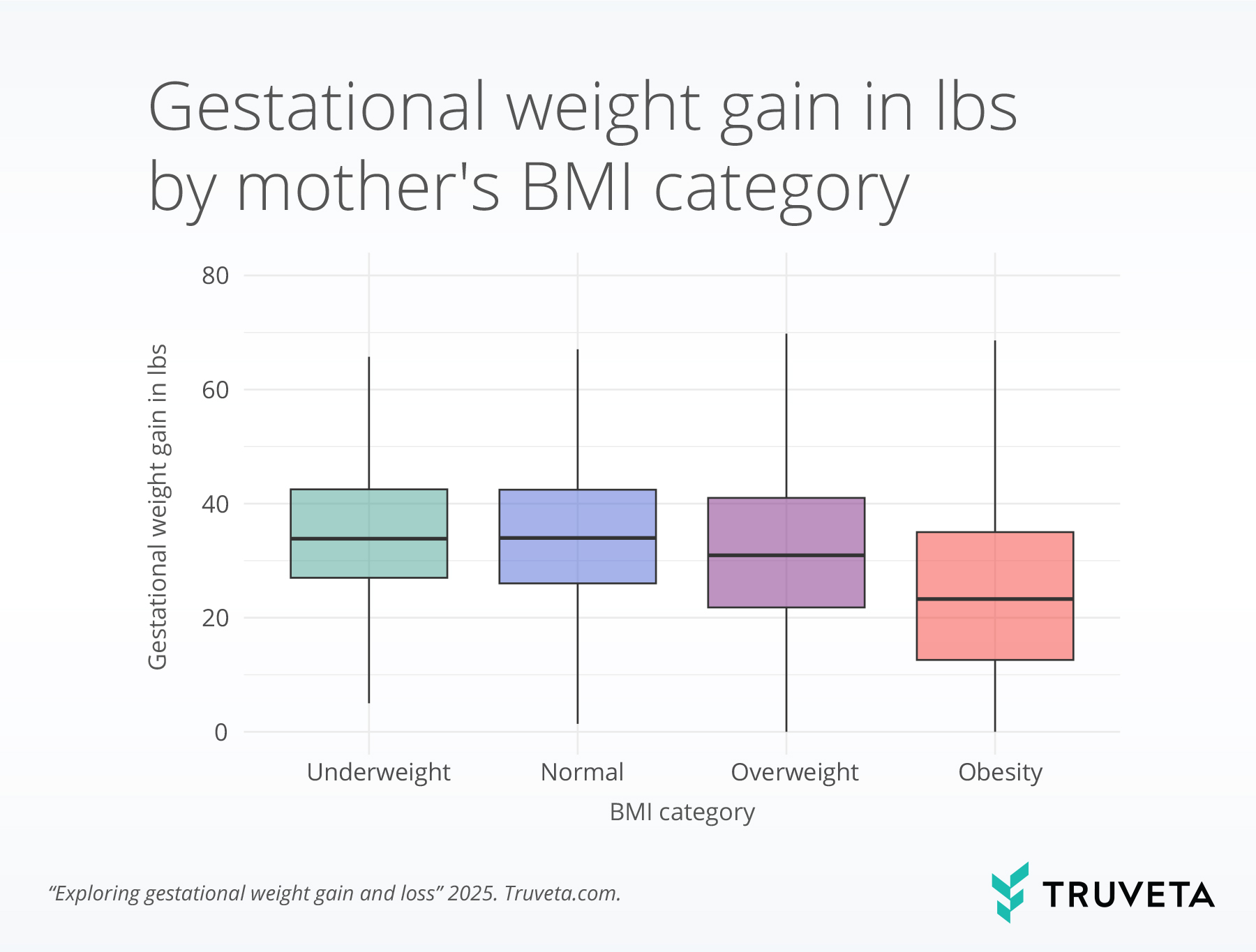
These trends varied by age as well.
Among mothers without obesity, older mothers gained less weight during pregnancy than younger mothers (mothers aged 40-50 years gained a median 30.0 pounds compared with a median 35.5 pounds for those aged 18-24 years).
Among mothers with obesity, we observed smaller differences in weight gain during pregnancy (those aged 40-50 years gained a median 23.0 pounds vs. those aged 18-24 gained a median 25.0 pounds).
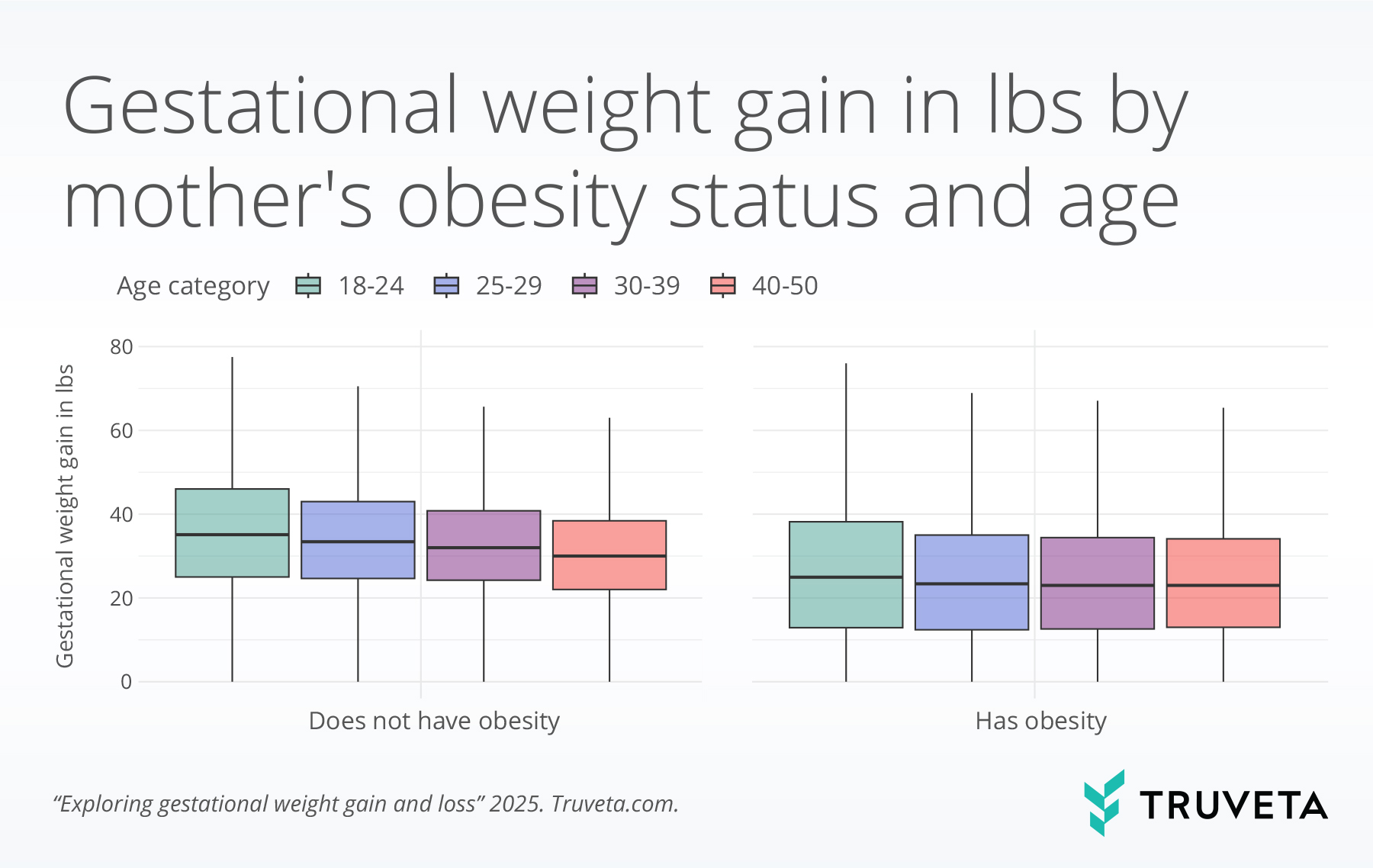
Gestational weight loss patterns
Most mothers (55%) did not have a recorded weight loss in which they dropped below their starting, pre-pregnancy weight at any point, but among the 45% who did have a recorded weight loss, clear differences appeared by BMI category. We observed that increasing BMI category was associated with greater weight loss. Mothers with obesity lost a median 7.0 pounds, more than 2.5-fold the weight loss among those who were underweight (median 2.7-pound weight loss). The median weight loss percent (of starting weight) ranged from 2.5% for those who were underweight or normal weight to 3.2% for those with obesity. We did not observe major differences in weight gain or weight loss during pregnancy by race or ethnicity.
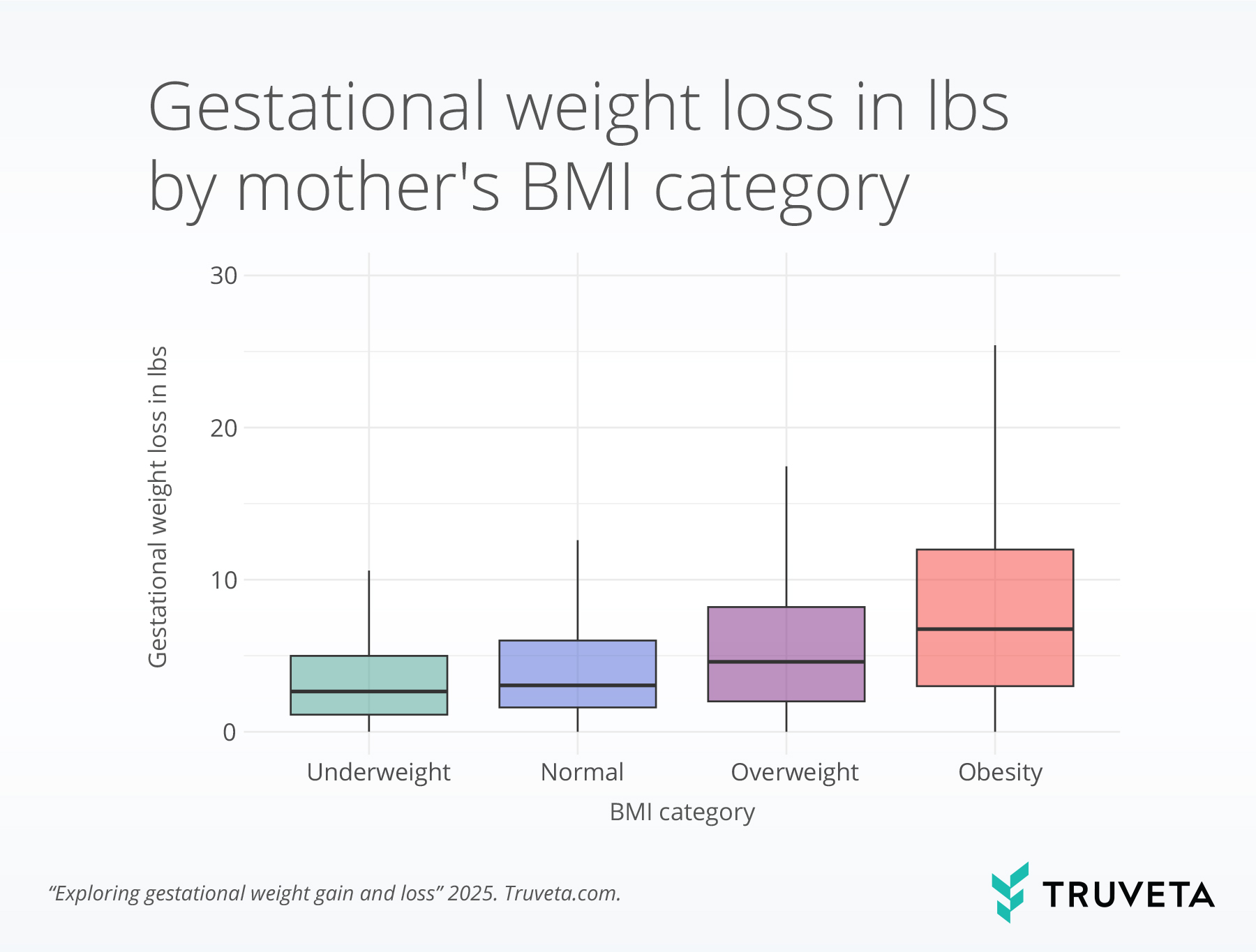
Discussion
We found most pregnant mothers with a BMI category of underweight or normal at the start of pregnancy gained weight within the ACOG guidelines (4). Both mothers who were underweight and normal gained a median 34 pounds. By contrast, mothers with overweight and obesity gained more than the recommendations, a median of 31 and 23.5 pounds, respectively. A systematic review of maternal weight change and infant outcomes found that in 47% of pregnancies, gestational weight gain was above recommended guidelines (5).
We also found that weight gain during pregnancy appeared to show a modest decrease with age, and this pattern held true across mothers with and without obesity at baseline. A 2007 report from the National Academies highlights that the impact of maternal age on gestational weight gain has only been studied in very young (adolescent) mothers, and a study from China found that women over age 35 were more likely to have overweight or obesity prior to pregnancy, but gained less weight than those in the 31-34 year age group during pregnancy. (6) Additional research in this area to explore the relationship between maternal age and gestational weight gain is warranted, as advanced maternal age is a risk factor for adverse perinatal outcomes (e.g., postpartum hemorrhage and eclampsia for the mother) and infant outcomes (e.g., preterm birth and low birthweight) (7). Excessive gestational weight gain is also associated with higher risk of cesarean sections, hypertensive disorders of pregnancy, large for gestational age infants, and admission to the NICU (8).
We found that just under half of mothers dropped below their pre-pregnancy weight during pregnancy, indicating that some weight loss during the first trimester is quite common. Participants experienced only modest weight loss, with all BMI groups losing a median of 3.2% or less of their starting weight. This amount falls below the 5–10% loss in the first trimester that is typically considered a worrisome indicator of excessive weight loss (9).
This analysis has several limitations. There are likely many factors that influence maternal weight gain, including comorbidities, classification of a pregnancy as ‘high risk’ due to placental or genetic conditions, or underlying metabolic conditions, such as presence of gestational diabetes, that could impact weight loss and/or gain during the pregnancy. This analysis only focused on maternal gestational weight loss and gain and thus was unable to evaluate any causal associations due to the lack of consideration of confounders.
Ultimately, this analysis highlights the role that objective observation weight and BMI data, collected as a standard part of prenatal care, can play to accurately calculate weight loss and gain over the course of a woman’s pregnancy. By relying on objective data rather than maternal recall, this method avoids many of the limitations of retrospective or survey-based analyses, providing more reliable and accurate estimates of weight change. Understanding maternal weight trajectories is only part of the story—in a follow-up analysis, we extend this work by connecting material weight gain patterns to infant weight at birth.
These are preliminary research findings and not peer reviewed. Data are constantly changing and updating. These findings are consistent with data accessed on September 5, 2025.
Citations
- First global call for data on gestational weight gain. https://www.who.int/news-room/articles-detail/first-global-call-for-data-on-gestational-weight-gain.
- C. Scott, C. T. Andersen, N. Valdez, F. Mardones, E. A. Nohr, L. Poston, K. C. Q. Loetscher, B. Abrams, No global consensus: a cross-sectional survey of maternal weight policies. BMC Pregnancy Childbirth 14, 167 (2014).
- J. A. Hutcheon, O. Stephansson, S. Cnattingius, L. M. Bodnar, K. Johansson, Is the Association Between Pregnancy Weight Gain and Fetal Size Causal? Epidemiol. Camb. Mass 30, 234–242 (2019).
- Weight Gain During Pregnancy | ACOG. https://www.acog.org/clinical/clinical-guidance/committee-opinion/articles/2013/01/weight-gain-during-pregnancy.
- R. F. Goldstein, S. K. Abell, S. Ranasinha, M. Misso, J. A. Boyle, M. H. Black, N. Li, G. Hu, F. Corrado, L. Rode, Y. J. Kim, M. Haugen, W. O. Song, M. H. Kim, A. Bogaerts, R. Devlieger, J. H. Chung, H. J. Teede, Association of Gestational Weight Gain With Maternal and Infant Outcomes: A Systematic Review and Meta-analysis. JAMA 317, 2207–2225 (2017).
- Y. Wang, Y. Gong, Y. Xu, X. Wang, S. Shan, G. Cheng, B. Zhang, Maternal age-specific risks for adverse birth weights according to gestational weight gain: a prospective cohort in Chinese women older than 30. BMC Pregnancy Childbirth 24, 36 (2024).
- P. A. Cavazos-Rehg, M. J. Krauss, E. L. Spitznagel, K. Bommarito, T. Madden, M. A. Olsen, H. Subramaniam, J. F. Peipert, L. Jean Bierut, Maternal age and risk of labor and delivery complications. Matern. Child Health J. 19, 1202–1211 (2015).
- K. Goławski, W. Giermaziak, M. Ciebiera, C. Wojtyła, Excessive Gestational Weight Gain and Pregnancy Outcomes. J. Clin. Med. 12, 3211 (2023).
- Is My Morning Sickness ‘Normal’?, Cleveland Clinic. https://health.clevelandclinic.org/is-my-morning-sickness-normal.

